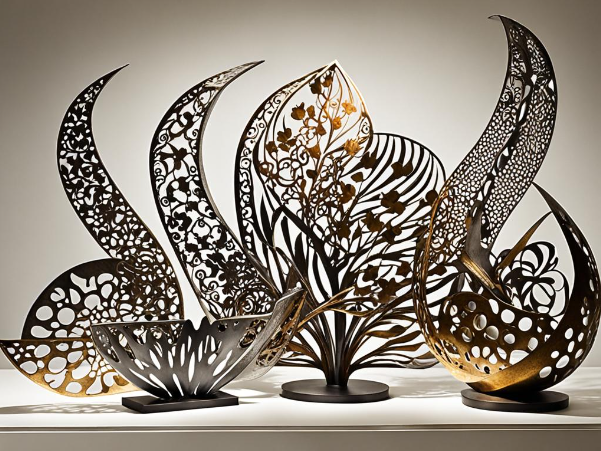Metal art is more than just an aesthetic choice; it’s a form of expression that combines creativity with craftsmanship. From intricate sculptures to stunning wall hangings, metal art captivates our senses and adds a unique dimension to any space. As you explore the world of metal art, you’ll discover how this genre has evolved over time and the various techniques artists use to bring their visions to life. Whether you’re a seasoned collector or just beginning your journey into this fascinating realm, there’s much more waiting for you in the shimmering landscape of metal creations. Let’s dive deeper into what makes metal art so special!
What is Metal Art?
Metal art is a captivating genre that transforms raw materials into visually stunning creations. It encompasses various forms, including sculptures, wall decor, and functional pieces like furniture or garden ornaments.
Artists use different metals such as steel, aluminum, and copper to craft their work. The choice of material often influences the final design and feel of the piece.
This medium allows for incredible versatility in style. From sleek modern designs to rustic motifs, metal art can evoke emotions while enhancing any environment.
The durability of metal also adds an element of permanence to these artworks. Unlike other mediums that may degrade over time, well-crafted metal pieces stand resilient against the elements.
Whether hung on walls or displayed in gardens, metal art serves not just as decoration but also as a conversation starter. Its unique textures and finishes invite curiosity and admiration from all who encounter it.
The History and Evolution of Metal Art
Metal art has deep roots that stretch back thousands of years. Ancient civilizations utilized metalwork for both functional and artistic purposes. From intricate jewelry in Egypt to robust sculptures in ancient Greece, metal was a favored medium.
During the Middle Ages, blacksmiths became crucial figures. They crafted everything from tools to decorative pieces, showcasing their skills through ornate gates and railings. The Renaissance reignited interest in metal as an art form, leading to more expressive designs.
As industrialization progressed, new techniques emerged. Artists began experimenting with welding and casting methods. This shift opened doors for contemporary expressions of creativity.
Today, metal art reflects a blend of tradition and modernity. Artists are pushing boundaries by combining metals with other materials like glass or wood. The evolution continues as new technologies create endless possibilities for innovation within this captivating genre.
Different Techniques Used in Metal Art
Metal art encompasses a variety of techniques that bring creativity to life. Welding is one of the most common methods, where artists fuse pieces together to create intricate sculptures. This process allows for strong and durable structures.
Another popular technique is metal casting. Here, molten metal is poured into molds, resulting in unique shapes and designs once cooled. It offers endless possibilities for artistic expression.
Cutting is also widely used in this genre. Artists utilize plasma cutters or saws to slice through sheets of metal, crafting detailed patterns and forms. The precision involved can yield stunning results.
Patination adds an aesthetic flair by chemically altering the surface of metals like copper or bronze. This technique creates beautiful color variations that enhance the overall artwork’s appeal while giving it character over time. Each method contributes its own charm and intricacy to the world of metal art.
The Versatility of Metal as a Medium
Metal art stands out for its incredible versatility. Artists can manipulate various metals like steel, copper, and aluminum to create stunning pieces that range from sculptures to intricate wall hangings.
The medium allows for a blend of styles too. Whether it’s sleek modern designs or rustic vintage looks, metal adapts beautifully. This flexibility means artists can express their individuality through texture and form.
Moreover, metal is durable. Unlike some materials that may fade or deteriorate over time, metal retains its charm in diverse environments—both indoors and outdoors.
It also lends itself well to mixed media projects. Combining metal with wood, glass, or ceramics leads to unique artistic expressions that captivate viewers.
Whether used in large installations or small decorative items, the possibilities are endless when it comes to incorporating metal into art forms. Each piece tells a story defined by the artist’s vision and imagination.
Famous Metal Artists and Their Works
Metal art has been shaped by numerous talented artists who have pushed the boundaries of creativity. One standout is David Smith, an American sculptor known for his innovative use of scrap metal. His works, often monumental in scale, reflect a unique blend of geometry and movement.
Another influential figure is Alberto Giacometti. His elongated figures made from bronze convey emotion and depth, transforming how we perceive human form through metal.
Then there’s Ruth Asawa, celebrated for her intricate wire sculptures that dance between two-dimensionality and three-dimensionality. Her pieces invite viewers to explore light and shadow in mesmerizing ways.
Consider John Lopez. His larger-than-life sculptures pay homage to the American West using repurposed materials. Each piece tells a story steeped in history while showcasing modern artistry at its finest.
How to Incorporate Metal Art into Your Home Decor
Incorporating metal art into your home decor can transform any space. Start by choosing a focal point, like a large wall piece above a sofa or fireplace. This draws the eye and sets the tone for the room.
Mix different sizes of metal art to create depth. A small sculpture on a shelf paired with larger wall hangings adds interest without overwhelming the area.
Consider color and finish when selecting pieces. Rustic finishes work well in cozy spaces, while sleek metallics complement modern designs beautifully.
Don’t shy away from outdoor areas; metal garden sculptures or wind chimes can enhance your landscape too. They add charm and character while standing up to weather conditions.
Think about lighting. Spotlights highlighting your metal art can create stunning effects that shift throughout the day, bringing life to your decor choices.
The Growing Popularity of Metal Art in Modern Society
Metal art has found a special place in modern society, resonating with people of all ages and backgrounds. Its unique blend of creativity and craftsmanship attracts both collectors and casual admirers alike. As the world becomes more visually driven, the demand for distinctive home decor is escalating.
Social media platforms are buzzing with artists showcasing their stunning metal creations. This exposure not only promotes individual talents but also fosters a community that appreciates innovation in metalworking. The rise of online marketplaces further broadens access to these extraordinary pieces, making it easier than ever to acquire unique artworks.
Sustainability plays a role too; many contemporary metal artists focus on using reclaimed materials. This eco-conscious approach appeals to environmentally aware consumers looking for meaningful art that reflects their values.
Public spaces are increasingly featuring large-scale metal sculptures as part of city beautification projects or park installations. These impactful pieces enhance urban landscapes while drawing attention to local talent.
As we move forward, metal art continues to evolve and adapt, pushing boundaries in design and functionality. Its versatility ensures that it remains relevant across generations—an enduring testament to human creativity at its finest.




















